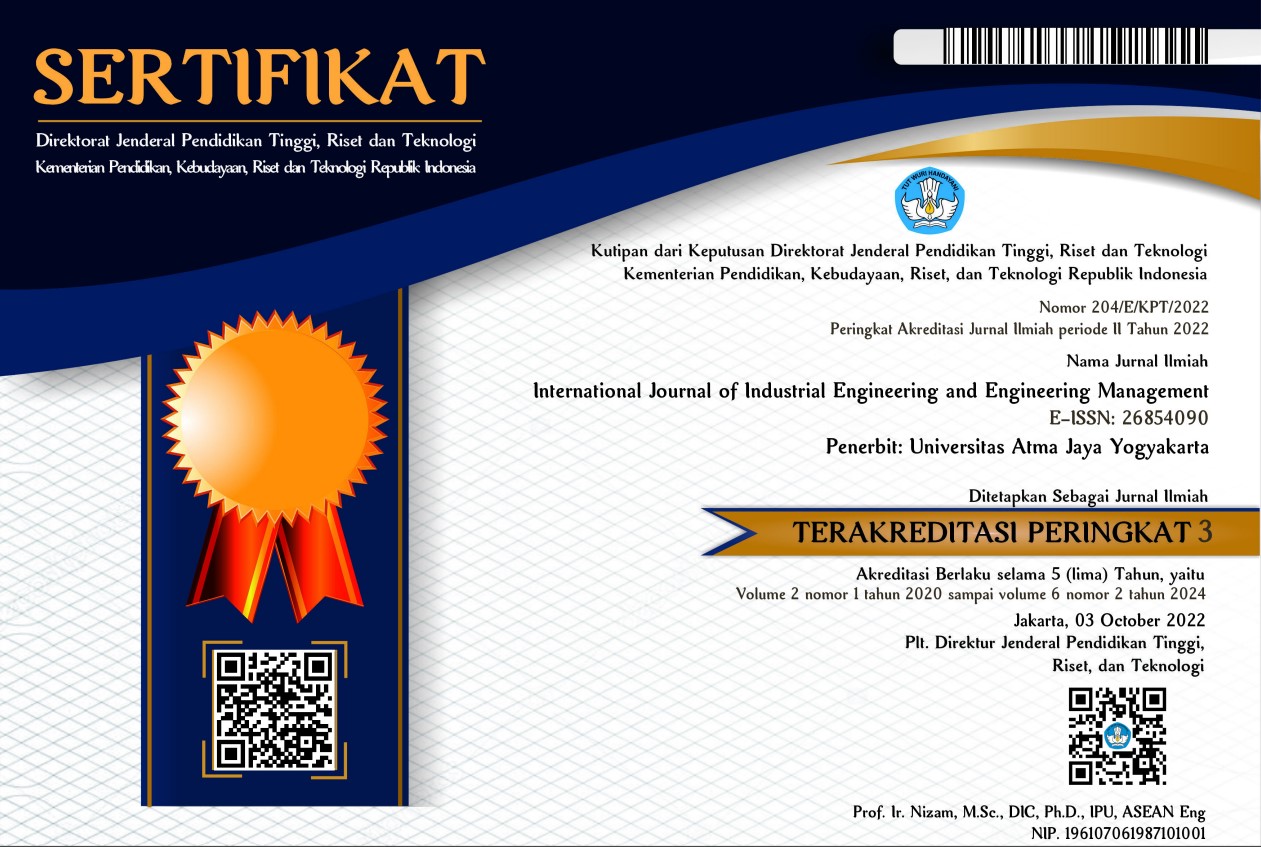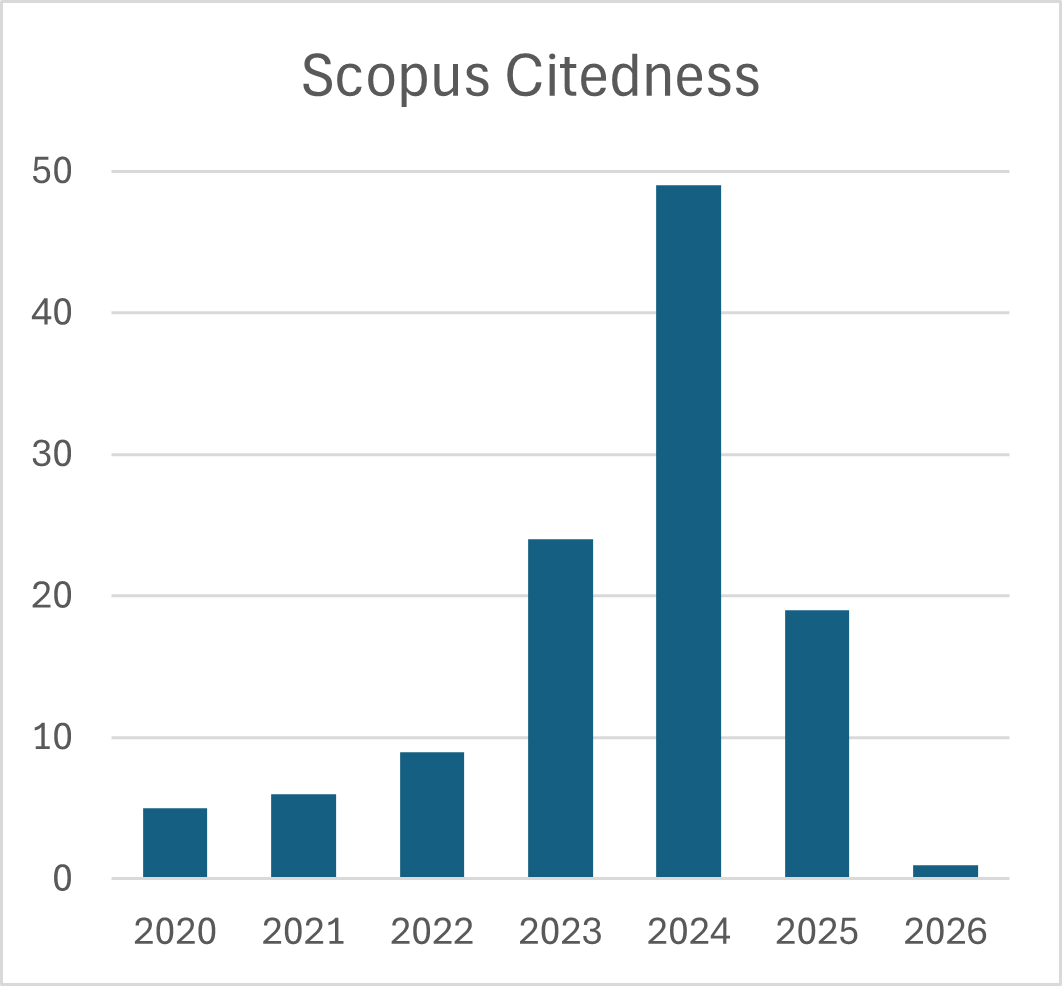Optimizing Turning Parameters for The Turning Operations of Inconel X750 Alloy with Nanofluids Using Direct and Aspect Ratio-based Taguchi Methods
DOI:
https://doi.org/10.24002/ijieem.v3i2.5457Keywords:
Turning process, Taguchi method, aspect ratios, optimisation, prioritization.Abstract
For the turning process, the computation of optimal parametric settings for parameters has been traditionally achieved using standard parametric values, but comparative values between the standard parameters have been ignored. But these aspect ratios reveal some evaluation dimensions that account for robust measurement schemes that promote enhanced effectiveness of the process. To address the issue, an aspect-ratio-based mechanism has been introduced to optimize the turning parameters in three Taguchi methodical variants of classical Taguchi, Taguchi-Pareto, and Taguchi-ABC methods. A total of twelve alternatives were developed, with each alternative containing three standard parameters and two aspect ratios since only three standard parameters are involved in the evaluation. The evaluation of parameters in non-prioritized and prioritized forms was considered for each alternative. The Taguchi method accounts for the non-prioritized method, while Taguchi-Pareto and Taguchi-ABC methods are the prioritized parametric structures. The delta values and ranks across the prioritized and non-prioritized parameters were evaluated by their mean values. The optimal parametric settings were evaluated for all alternatives in the prioritized and non-prioritized forms of evaluation. The results, using literature data, confirmed the feasibility of using the approach. The outcome of the methods is in enhancing the planning scheme for the turning operation. The benefit of the study is an enhanced analysis of turning operation’s improvements and estimation of related economic advantages through turning resources conservation.
References
Ajibade, O.A., Agunsoye, J.O., & Oke, S.A. (2019). Optimisation of water absorption parameters of dual-filler filled composites using Taguchi and moderated Taguchi techniques. Kufa Journal of Engineering, 10(2), 134-151.
Ajibade, O.A., Agunsoye, J.O., & Oke, S.A., (2021). Taguchi method and Taguchi-Pareto scheme to evaluate diffusivity during the development of orange peel epoxy composites. Journal of Applied Science & Process Engineering, 8(1), 765-785.
Ajibade, O.A., Agunsoye, J.O., & Oke S.A. (2016). Tapped density optimisation for four agricultural wastes: Part II - Performance analysis, main effects of process parameters and Taguchi-Pareto. Acta Periodica Technologica, 47, 129-142.
Barewar, S.D., Kotwani, A., Choughe, S.S., & Unune, D.R. (2021). Investigating a novel Ag/ZnO based hybrid nanofluid for sustainable machining of Inconel 718 under nanofluid based minimum quantity lubrication. Journal of Manufacturing Processes, 66, 313-324.
Boubekri, N. & Shaikh, V.A. (2015). Minimum quantity lubrication (MQL) in machining: Benefits and drawbacks. Journal of Industrial and Intelligent Information, 3(3), 205-209.
Cardwell, S. (2015). A sense of proportion: Aspect ratio and the framing of television space. Critical Studies in Television: The International Journal of Television Studies, 10(3), 83-100.
Chetan, Behera, B.C., & Rao, P.V. (2016). Application of nano fluids during minimum quality lubrication: a case study in turning process. Tribology International, 101, 234-246.
Chinchanikar, S., Kore, S.S., & Hujaree, P. (2021). A review on nanofluids in minimum quantity imbrication machining. Journal of Manufacturing Processes, 68, 56-70.
Das, A., Pradhan, O., Patel, S.K., & Das, S.R. (2019). Performance appraisal of various nanofluids during hard machining of AISI 4340 steel. Journal of Manufacturing Processes, 46, 248-270.
Elsheikh, A.H, Elaziz, M.A., Das, S.R., Muthuramalingam, T., & Lu, S. (2021). A new optimized predictive model based on political optimizer for eco-friendly MQL-turning of AISI 4340 alloy with nano-lubricants. Journal of Manufacturing Processes, 67, 562-578.
Esfe, M.H., Bahiraei, M., & Mir, A. (2020). Application of conventional and hybrid nano fluids in different matching processes: A critical review. Advance in Colloid and Interface Science, 282, article 102199.
Gunantara, N. (2018). A review of multi-objective optimization: Method and its applications. Cogent Engineering, 5(1), 3-5.
Joshi, K.K., Behera, R.K., & Anurag, K. (2018). Effect of minimum quantity lubrication with Al2O3 nanofluid on surface roughness and its prediction using hybrid fuzzy controller in turning operation of Inconel 600. Materials Today: Proceedings, 5(9), 20660-20668.
Junankar, A.A., Parate, S.R., Dethe, P.K., Dhote, N.R., Gadkar, D.G., Gadkar, D.D., & Gaybhiye, S.A. (2021). A review: Enhancement of turning process performance by effective utilization of hybrid nanofluid and MQL. Materials Today: Proceedings, 38, 44-47.
Junankar, A.A., Parate, S.R., Dethe, P.K., Dhote, N.R., Gadkar, D.G., Gadkar, D.D., & Gajbhiye, S.A. (2021). Optimization of bearing steel turning parameters under CuO and ZnO nanofluid-MQL using MCDM hybrid approach. Materials Today: Proceedings, 47(14), 4292-4297.
Kannan, V. & Kannan, V. (2018). A comparative study on machinability characteristics in dry machining of inconel X-750 alloy using coated carbide inserts. SAE Technical Paper.
Khan, A.M., Gupta, M.L., Heg, H., Jamil, M., Mia, M., He, N., Song, Q., Liu, Z., & Pruncu, C.I. (2020). Energy-based cost integrated and sustainability assessment of Al-GnP hybrid nanofluid assisted turning of AISI 52100 steel. Journal of Cleaner Production, 257, Article120502.
Kumar, M.S., & Krishna, V.M. (2020). An investigation on turning AISI 1018 steel with hybrid biodegradable nanofluid/MQL incorporated with combinations of CuO-Al2O3 nanoparticles. Materials Today: Proceedings, 24(2), 1577-1584.
Marsh, C. (2018). The mechanical properties and deformation behavior of heat treated versus as-received inconel X-750, Master's Thesis, Department of Mechanical Engineering. College of Engineering and Computing, University of South Carolina, USA. Retrieved from https://scholarcommons.sc.edu/etd/4974.
Murali, K.V. & Varium, K.A. (2020). Investigation on influence of hybrid biodegradable nanofluids (CuO-ZnO) on surface roughness in turning AISI:1018 steel. Materials Today: Proceedings, 24, 1570-1576.
Oji, B.C. & Oke, S.A. (2020). Optimisation of bottling process using “hard” total quality management elements. The TQM Journal, 33(2), 473-502.
Okanminiwei, L. & Oke, S.A. (2020). Optimisation of maintenance downtime for handling equipment in a container terminal using Taguchi scheme, Taguchi-Pareto method and Taguchi-ABC method. Indonesian Journal of Industrial Engineering & Management, 1(2), 69-90.
Onwubolu, G. & Kumalo, T. (2001). Optimisation of multi pass turning operations with genetic algorithms. International Journal of Production Research, 39(16), 3727-3745.
Padmini, R., Krishna, P.V., & Rao, G.K.M. (2016). Effectiveness of vegetable oil based nanofluids as potential cutting fluids in turning AISI 1040 steel. Tribology International, 94, 490-501.
Petrovic, D. & Radovanici, M. (2013). Using genetic algorithms for optimization of turning machining process. Journal of Engineering Studies and Research, 19(1), 47-55.
Purohit, Y.K., Gohane, G.M., Rachbhaai, J.S., Gupta P.M., & Sayed A.R. (2021). Performance evaluation of Cu nanofluid in bearing steel MQL based turning operation. Materials Today: Proceedings, 44, 4309-4314.
Rahman, S.S., Ashraf, M.Z.I., Amin, A.K.M.N., Bashar, M.S., Ashik, M.F.K., & Kamruzzaman M. (2019). Tuning nanofluidsfor improved lubrication performance in turning biomedical grade titanium alloy. Journal of Cleaner Production, 206, 180-196.
Sarikaya, M., Sirin, S., Yildirim, C.V., Kivad, T., & Gupta, M.K. (2021). Performance evaluation of whisker-reinforced ceramic tools under nano-sized solid lubricants assisted MQL turning of co-based Haynes 25 superalloy. Ceramics International, 47(11), 15542-15560.
Sharma, P., Sidhub, S., & Sharma, J. (2015). Investigation of effects of nanofluids on turning of AISI D2 steel using minimum quantity lubrication. Journal of Cleaner Production, 108, 72-79.
Singh, R.K, Sharma, A.K., Mandal, B.V., Gaurav, K., Nag, A., Kumar, A., Dixi,t A.R., Mandal, A., & Das, A.K. (2018). Influence of graphene-based nanofluid with minimum quantity lubrication on surface roughness and cutting temperature in turning operation. Materials Today: Proceedings, 5(11), 24578-24586.
Singh, J. & Chatta, S.S. (2021). Tribological behavior of nanofluids under minimum quantity lubrication in turning of AISI 1055 steel. Materials Today: Proceedings, 41, 825-832.
Sirin, S., Sarikaya, M., Yildirim, C.V., & Kivak, T. (2021). Machinability performance of nickel alloy X-70 with SiAlON ceramic cutting tool under dry, MQL and LBN mixed nanofluid-MQL. Tribology International, 153, Article106673.
Special Metals. (2004). Inconel X-750, Publication No. SMC-067, Special Metals Corporation, www.specialmetals.com, Accessed 8th January, 2022.
Sridhara, V. & Satapathy, L.N. (2011). Al2O3–based nanofluids: A review. Nanoscale Research Letters, 6, Article456.
Tanmaisaigeetha, C.H., Dash, A.K., Kavya, B., & Amrita, M. (2021). Analysis of hybrid nanofluids in machining AISI 4340 using minimum quantity lubrication. Materials Today: Proceedings, 43(1), 579-586.
Ujiie, H., Tamano, Y., Sasaki, K., & Hori, T. (2001). Is the aspect ratio a reliable index for predicting the rupture of a saccular aneurysm? Neurosurgery, 48(3), 495-503.
Ukamanal, M., Mishra, P.C., & Sahoo, A.L. (2018). Temperature distribution during AISI 316 steel turning under TiO2-water based nanofluid spray environment. Materials Today: Proceedings, 5(9), 20741-20749.
Venkatesan, K., Patel, J.K, Raval, G.V., & Shaj H.V. 2018, A comparative study of tool wears in dry turning of Inconel X 750 and waspaloy, Materials Today: Proceedings, 5, 13429-13437.
Venkatesan, K., Arun, T.M., Devendiran, S., Ghazaly, N.M., Sanjith, S., & Raghul, R. (2019c). Machinability study and multi-response optimization of cutting force, surface roughness and tool wear on CNC turned Inconel 617 superalloy using Al2O3 nanofluids in coconut oil. Procedia Manufacturing, 30, 396-403.
Venkatesan, K., Devendiran, S., Ghazaly, N.M., Rahel, R., & Maghilan, T. (2019a). Optimization of cutting parameters on turning of Incoloy 800H using Al2O3 nanofluid in coconut oil. Procedia manufacturing, 30, 268-275.
Venkatesan, K., Devendiran, S., Ghazaly, N.M., & Nishanth. (2019b). Application of Taguchi-response surface analysis to optimize the cutting parameters on turning of Inconel X-750 nano-fluids suspended Al2O3 in coconut oil. Procedia Manufacturing, 30, 90-97.
Wang, X., Li, C., Zhang, Y., Ding, W., Yang, M., Gao, T., Cao, H., Xu ,X., Wang, D., Said, Z., Debnath, S., Jamil, M., & Ali H.M. (2020). Vegetable oil-based nanofluid minimum quantity lubrication turning: Academic review and perspectives. Journal of Manufacturing Processes, 59, 76-97.
Yi, S., Mo, J., & Ding, S. (2019). Experimental investigation on the performance and mechanism of graphene oxide nanofluids in turning Ti-6AL-4V. Journal of Manufacturing Processes, 43, 164-174.
Yi, S., Li, J., Zhi J., Wang, X., Mo, J., & Ding, S. (2020). Investigation of machining Ti-6Al-4V with graphene oxide nanofluids: Tool wear, cutting forces and cutting vibration. Journal of Manufacturing Processes, 49, 35-49.
Yildirim, C.V. (2020). Investigation of hard turning performance of eco-friendly cooling strategies: Cryogenic cooling and nanofluid based MQL. Tribology International, 144, Article106127.
Yildirim, C.V., Sarikaya, M., Kivak, K., & Sirin, S. (2019). The effect of addition of HBN nanoparticles to nanofluid MQL on tool wear patterns, tool life, roughness and temperature in turning of Ni-based Inconel 625. Tribology International, 134, 443-456.
Downloads
Published
How to Cite
Issue
Section
License
Copyright (c) 2021 International Journal of Industrial Engineering and Engineering Management

This work is licensed under a Creative Commons Attribution 4.0 International License.








